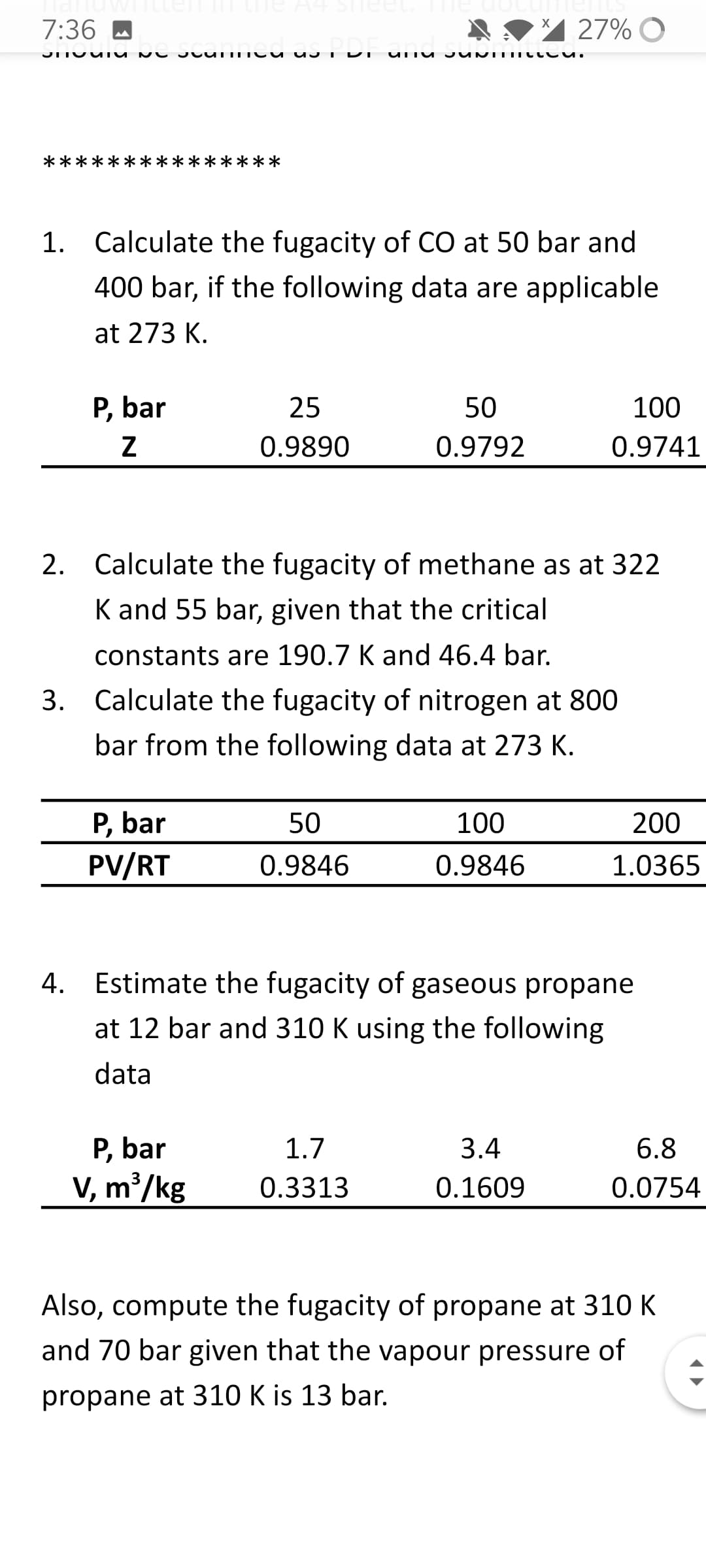1. Calculate the fugacity of CO at 50 bar and 400 bar, if the following data are applicable at 273 K. P, bar 25 50 100 0.9890 0.9792 0.9741
1. Calculate the fugacity of CO at 50 bar and 400 bar, if the following data are applicable at 273 K. P, bar 25 50 100 0.9890 0.9792 0.9741
Introduction to Chemical Engineering Thermodynamics
8th Edition
ISBN:9781259696527
Author:J.M. Smith Termodinamica en ingenieria quimica, Hendrick C Van Ness, Michael Abbott, Mark Swihart
Publisher:J.M. Smith Termodinamica en ingenieria quimica, Hendrick C Van Ness, Michael Abbott, Mark Swihart
Chapter1: Introduction
Section: Chapter Questions
Problem 1.1P
Related questions
Question

Transcribed Image Text:7:36 M
I♥Z 27% O
**
<***
1. Calculate the fugacity of CO at 50 bar and
400 bar, if the following data are applicable
at 273 K.
P, bar
25
50
100
0.9890
0.9792
0.9741
2. Calculate the fugacity of methane as at 322
K and 55 bar, given that the critical
constants are 190.7 K and 46.4 bar.
3. Calculate the fugacity of nitrogen at 800
bar from the following data at 273 K.
P, bar
PV/RT
50
100
200
0.9846
0.9846
1.0365
4. Estimate the fugacity of gaseous propane
at 12 bar and 310 K using the following
data
P, bar
V, m/kg
1.7
3.4
6.8
0.3313
0.1609
0.0754
Also, compute the fugacity of propane at 310 K
and 70 bar given that the vapour pressure of
propane at 310 K is 13 bar.
Expert Solution
This question has been solved!
Explore an expertly crafted, step-by-step solution for a thorough understanding of key concepts.
This is a popular solution!
Trending now
This is a popular solution!
Step by step
Solved in 5 steps

Knowledge Booster
Learn more about
Need a deep-dive on the concept behind this application? Look no further. Learn more about this topic, chemical-engineering and related others by exploring similar questions and additional content below.Recommended textbooks for you

Introduction to Chemical Engineering Thermodynami…
Chemical Engineering
ISBN:
9781259696527
Author:
J.M. Smith Termodinamica en ingenieria quimica, Hendrick C Van Ness, Michael Abbott, Mark Swihart
Publisher:
McGraw-Hill Education

Elementary Principles of Chemical Processes, Bind…
Chemical Engineering
ISBN:
9781118431221
Author:
Richard M. Felder, Ronald W. Rousseau, Lisa G. Bullard
Publisher:
WILEY

Elements of Chemical Reaction Engineering (5th Ed…
Chemical Engineering
ISBN:
9780133887518
Author:
H. Scott Fogler
Publisher:
Prentice Hall

Introduction to Chemical Engineering Thermodynami…
Chemical Engineering
ISBN:
9781259696527
Author:
J.M. Smith Termodinamica en ingenieria quimica, Hendrick C Van Ness, Michael Abbott, Mark Swihart
Publisher:
McGraw-Hill Education

Elementary Principles of Chemical Processes, Bind…
Chemical Engineering
ISBN:
9781118431221
Author:
Richard M. Felder, Ronald W. Rousseau, Lisa G. Bullard
Publisher:
WILEY

Elements of Chemical Reaction Engineering (5th Ed…
Chemical Engineering
ISBN:
9780133887518
Author:
H. Scott Fogler
Publisher:
Prentice Hall


Industrial Plastics: Theory and Applications
Chemical Engineering
ISBN:
9781285061238
Author:
Lokensgard, Erik
Publisher:
Delmar Cengage Learning

Unit Operations of Chemical Engineering
Chemical Engineering
ISBN:
9780072848236
Author:
Warren McCabe, Julian C. Smith, Peter Harriott
Publisher:
McGraw-Hill Companies, The